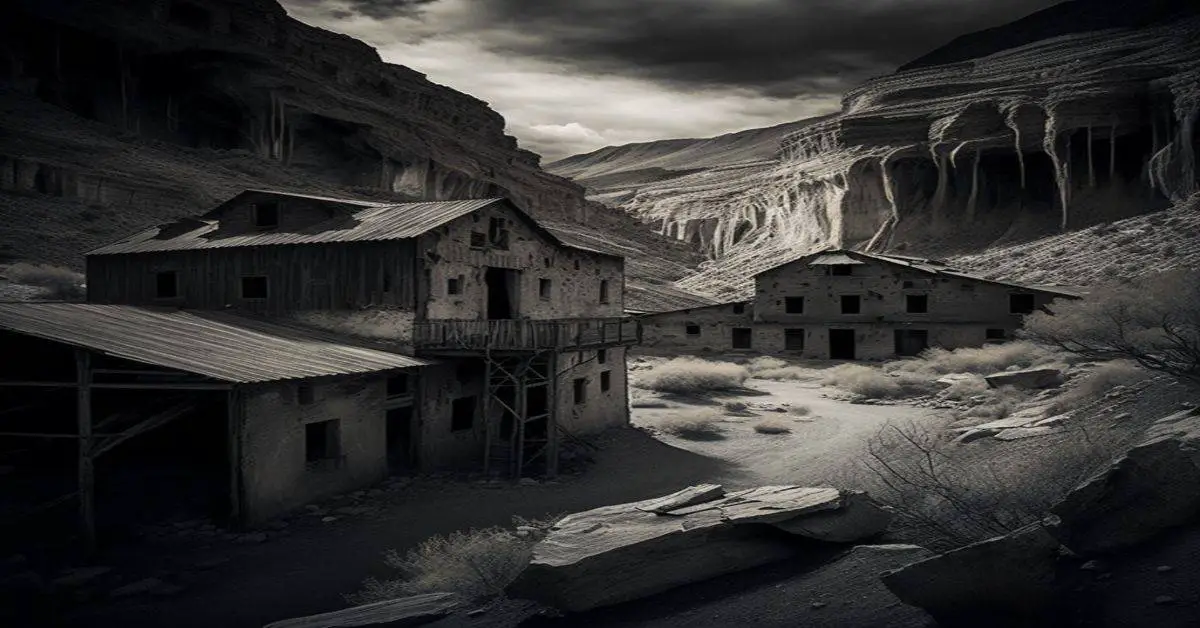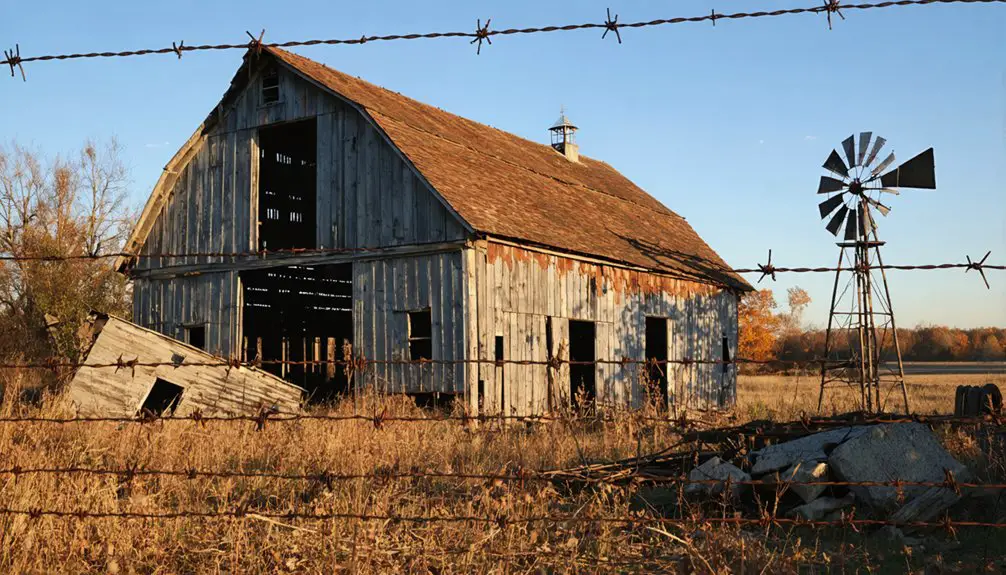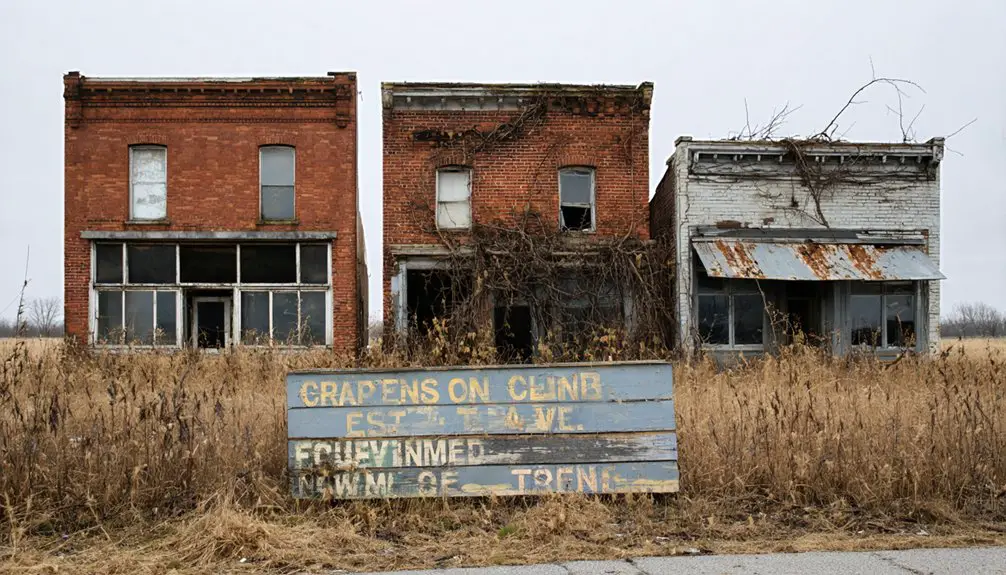You’ll discover Utopia, Ohio’s ghostly remains along the Ohio River, where Charles Fourier’s followers established an experimental commune in 1844. This socialist settlement thrived until December 13, 1847, when a devastating flood killed seventeen people during a spiritual gathering at the riverside town hall. Today, mysterious underground ruins and reported paranormal activity mark the site where this utopian dream met its tragic end. The full story of Utopia’s transformation holds even darker secrets.
Key Takeaways
- Founded in 1844 as an experimental utopian settlement, Utopia, Ohio was established by Charles Fourier’s followers seeking to create a perfect society.
- The community reached its peak in the mid-1850s with forty buildings before declining, eventually becoming a ghost town.
- A devastating flood in 1847 killed seventeen people and destroyed the town hall, leading many survivors to abandon their properties.
- Mysterious ruins beneath the soil, often mistaken for an “Underground Church,” remain as evidence of the former settlement.
- Visitors report paranormal activity, including unexplained noises and temperature drops, particularly near the ruins during rainy nights.
The Birth of a Utopian Dream
In the wake of the failed Clermont Phalanx experiment, a group of Charles Fourier’s followers established Utopia, Ohio in 1844, driven by their vision of creating a perfect cooperative society.
You’ll find their foundational ideals reflected in the very name they chose, embodying their hope for a harmonious future spanning 35,000 years of peace.
For just $25 annually per family, you could’ve joined this ambitious venture, securing a wooden house and land parcel within the community.
Their communal aspirations took shape through a market socialist economy based on Josiah Warren’s labor theory of value.
The settlers of Utopia, Ohio embraced Warren’s labor theory of value, blending market economics with socialist principles of shared prosperity.
The experiment initially struggled as resident fees proved insufficient to maintain the community’s operations.
While individual families maintained private homes, the settlement’s structure emphasized cooperative living and shared investment in both capital and labor, marking a bold experiment in American utopianism.
Like many utopian social theories throughout history, the community’s idealistic vision aimed to create a more equitable society through radical reorganization.
Fourier’s Vision Takes Root
The ambitious settlers of Utopia, Ohio drew direct inspiration from Charles Fourier‘s revolutionary social theories, particularly his concept of the phalanstery – a carefully planned communal dwelling designed to house 1,620 residents.
You’ll find Fourier’s influence reflected in four key aspects of Utopia’s development:
- The settlement’s phalanstery design emphasized cooperative living spaces organized by wealth and occupation. The community adopted Fourier’s belief in absolute passionate attraction as the foundation for their social organization.
- Work assignments matched residents’ natural passions and interests, with higher pay for less desirable tasks.
- The community structured itself around Fourier’s law of passionate attraction, aiming to liberate members from industrial society’s constraints.
- Daily labor was divided into two-hour segments with frequent breaks, allowing settlers to pursue diverse activities that aligned with their desires. The settlers also established a social minimum wage that ensured basic necessities were provided to all community members regardless of their work contribution.
Warren and the Labor Theory Revolution
While Fourier’s ideas shaped Utopia’s early vision, Josiah Warren’s revolutionary labor theory transformed the Ohio settlement into America’s first practical experiment in mutualist economics.
You’ll find that Warren’s system of equitable commerce rejected both state socialism and exploitative capitalism, establishing a unique “labor for labor” exchange where time spent in productive work determined value.
After moving from Boston to Cincinnati, Warren established himself as a music teacher and orchestra leader while developing his economic theories.
The community embraced mutual aid principles through collective support networks and shared resources.
In this groundbreaking community of about 100 residents, you’d have used labor notes instead of conventional money, with prices set strictly by cost rather than profit.
Within just a few years, twelve working-class families achieved home ownership through this system.
Warren’s principles, first tested at his Cincinnati Time Store in 1827, proved remarkably successful in Utopia for over 25 years, demonstrating that free markets could thrive without capitalist exploitation.
The Wattles Era and Spiritualist Movement
Following Warren’s mutualist experiment, spiritualist leader John O. Wattles purchased the land and established a new community centered on Spiritualist beliefs and mediumship practices.
The Spiritual Brotherhood claimed they could communicate with the “other world” through strict moral and physical discipline. The group drew inspiration from Swedenborgian teachings about communicating with spirits.
Here’s what defined the Wattles era:
- The group relocated the town hall brick-by-brick to the Ohio River’s edge in 1847.
- They held séances and spiritual communion gatherings regularly.
- Members engaged in progressive reforms like abolitionism and women’s rights.
- The community suffered a devastating blow when the 1847 flood destroyed their hall.
The flood proved catastrophic, sweeping away both lives and infrastructure. Families paid just twenty-five dollars yearly for wooden houses and access to the land.
This tragedy marked a turning point for the spiritualist experiment, highlighting the precarious nature of their riverfront utopia.
The Fatal Flood of 1847
On December 13, 1847, catastrophic flooding along the Ohio River claimed seventeen lives when surging waters destroyed Utopia’s town hall during a community gathering.
Despite local warnings, John Otis Wattles’ followers had hastily relocated the building brick-by-brick from the hilltop to the vulnerable riverbank just before winter.
Ignoring pleas from neighbors, the Wattles group defiantly dismantled their hilltop meeting hall, rebuilding it beside the treacherous river.
As floodwaters rose feet above normal stage, the unstable structure became a death trap. The south wall washed out in the early hours, crushing occupants beneath falling debris while others drowned in the icy waters.
Among the dead was community leader John Cornell. The flood aftermath devastated the settlement’s infrastructure, and survivors soon abandoned their properties. The rising land prices eventually prevented any significant rebuilding efforts in the area.
While later attempts at community resilience emerged in the 1850s, the original spiritualist experiment never recovered, leaving Utopia to fade into a ghost town.
From Cooperative Living to Ghost Town
The story of Utopia, Ohio stands as a tribute to the rise and fall of three distinct utopian experiments. Through a series of fascinating social experiments, you’ll discover how this ambitious settlement evolved from Fourier’s socialist vision to its eventual ghost town status.
The community dynamics shifted dramatically through these key phases:
- Fourier followers established a cooperative society in 1844, paying $25 annually for housing and land.
- Spiritualists took over but faced tragedy when their relocated town hall collapsed in the 1847 flood.
- Josiah Warren’s individualist anarchist colony introduced innovative labor notes and “time stores.”
- The settlement gradually declined as residents abandoned their homes, leaving industrial buildings to decay.
Despite noble intentions to create various forms of utopia, each experiment ultimately succumbed to practical challenges and changing times. By the mid-1850s, the settlement reached its peak with forty buildings constructed, split between residential and industrial purposes.
Haunted Legends and Underground Ruins
Deep beneath Utopia’s soil near the Clermont-Brown County border, mysterious underground ruins stand as silent witnesses to one of Ohio’s most tragic ghost stories.
On December 13, 1847, a devastating flood claimed the lives of spiritualist settlers during a dance party in their social hall near the Ohio River.
As the Ohio River rose that fateful December night in 1847, floodwaters swept through the hall, taking dancers to their watery doom.
You’ll find these haunting remnants of their gathering place, often mistaken for an “Underground Church,” where ghost sightings and paranormal activity persist to this day.
Visitors report dripping apparitions, unexplained noises, and sudden temperature drops, especially on rainy nights.
The spirits of those who perished seem restless – perhaps due to their secret rituals or their leader John O. Wattles’ fatal decision to relocate the community closer to the treacherous riverbank.
Frequently Asked Questions
What Happened to the Original Land Deeds After the Community Dispersed?
You’ll find that land ownership became fragmented after dispersal, with deed disputes arising from multiple transfers. Original deeds were either sold to new settlers or absorbed into surrounding private holdings.
Did Any Descendants of Original Utopia Settlers Still Live There Today?
You’ll find it challenging to confirm living descendants through historical records, though some residents remain in the area today. Limited descendant research hasn’t definitively linked current inhabitants to original settlers.
Were There Any Documented Interactions Between Utopia Residents and Neighboring Communities?
You’ll find evidence of community relations through land deals, store transactions, and warnings about flooding from neighboring towns, though tensions existed over Spiritualist practices and town hall relocation decisions.
What Crops or Goods Did the Community Produce During Its Cooperative Period?
With 5+ staple crops under cooperative farming, you’d see corn, wheat, and oats as primary yields, alongside diverse vegetables, fruits, and herbs grown on family plots near the Ohio River.
How Did Residents Handle Medical Care and Education in the Commune?
You’d find medical practices were handled internally by community members without formal doctors, while education methods relied on informal, home-based learning aligned with Fourierist and spiritualist philosophies.
References
- https://digging-history.com/2014/09/03/ghost-town-wednesday-utopia-ohio/
- https://digitalcommons.hamilton.edu/cgi/viewcontent.cgi?article=1414&context=acsq
- https://creepycincinnati.com/2016/07/18/utopia/
- https://www.youtube.com/watch?v=8imWf4vkOCQ
- https://en.wikipedia.org/wiki/Utopia
- https://www.thecollector.com/charles-fourier-passion-civilization-utopia/
- https://archive.org/details/TheUtopianVisionOfCharlesFourierSelectedTextsOnWorkLoveAndPassionateAttraction
- https://en.wikipedia.org/wiki/Charles_Fourier
- https://www.marxists.org/reference/archive/fourier/works/ch11.htm
- https://www.goodreads.com/book/show/1877701.The_Utopian_Vision_of_Charles_Fourier



